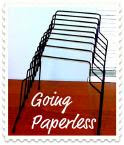
One of my areas of specialty in my productivity and organizing consulting work is paper management – helping my clients determine the best ways to process, manage and store the paper in their lives and in their work. I actually enjoy working with paper and processing information (hey, I’m a professional organizer, right?), but I know most people out there simply don’t. Many clients over the years have asked me about “going paperless,” without really knowing what that means. It’s something I’ve always been curious about, but needed an excuse to try and implement.
Paperless means processing and storing less paper than one had previously. Paper-free means, well, being completely free of paper – something I think is pretty tough to do with the sheer amounts of paper that seem to flow into our mailboxes no matter what we do. Going paperless, however, is absolutely doable, and not all that hard, as I’ve discovered first-hand.
At the beginning of 2009, I started the year with a fair amount of paper in my office - three file drawers full of important documents, and about fifteen binders of materials from seminars, classes and conferences. To some, a few file drawers of paper and some assorted binders may not be much at all, while to others, it may seem like a mountain of paper! For me, much of that paper was archival, and a great candidate for paperless reduction. So this January, I made a resolution to go as paper-less as possible, with a goal of reducing my stored paper by 75% or more. But how? Here are the steps I used to reduce my paper:
Whittle it. I’m pretty good about keeping my files down to the essentials, but even I was able to clear out about 15% of my stored paper by weeding through my old documents and removing what was no longer useful or relevant. It’s easiest to work on one drawer (or even one part of a drawer) at a time to avoid getting overwhelmed. Keep a recycle bin and a bag or box for shredding handy, and go through each file, folder, binder or document with a cold, hard eye and keep only what you really need – and toss the rest. You should be left with only your key documents. Put aside any unusual docs like official government notices (deeds, birth/death/marriage/divorce certificates).
Scan it. Keeping the paper that’s left simply isn’t necessary if you can find alternate ways of storing the information – it’s the information that’s valuable, not necessarily the paper. Especially in the age of easy searches on our computers, sometimes it makes perfect sense to centralize your information on your computer as much as possible. For me, I decided that while much of the information I wanted to keep was extremely valuable, the actual paper needed to go – so scanning was the answer. To facilitate the process, I chose a high-speed scanner/software solution from The Neat Company, called NeatWorks ADF. When you’re doing a major scanning project such as this one, you really need a scanner designed to scan multi-page documents, as well as software that can help facilitate the process. I recommend a solution that can scan to PDF in addition to a proprietary database. Once the documents are scanned and backed up, you can shred or recycle the originals.
Store it. Remember the unusual docs we set aside earlier, like government certificates, home loan docs, and other errata? Definitely scan those too, but I suggest keeping the originals somewhere safe, like a lockbox or safety deposit box. While you can get copies of them again from the agencies responsible, it’s usually a lot of trouble to do so, and simply easier to keep a small amount of these papers on hand.
By doing what I’ve described, I was able to dramatically reduce the amount of paper that I’m storing. In fact, everything has been edited down to one desktop file box about seven inches deep – that’s it. No big file drawers or boxes, no stacks of papers. One box, no more – all the old papers are gone now, with empty space left in their wake.
What are your paper reduction strategies? Have you tried going paperless?




1 comment:
Very nicely put and informative article, I am am moving and going paperless now is a great time for sure so I can have automated bill payments setup at my new place.
Post a Comment